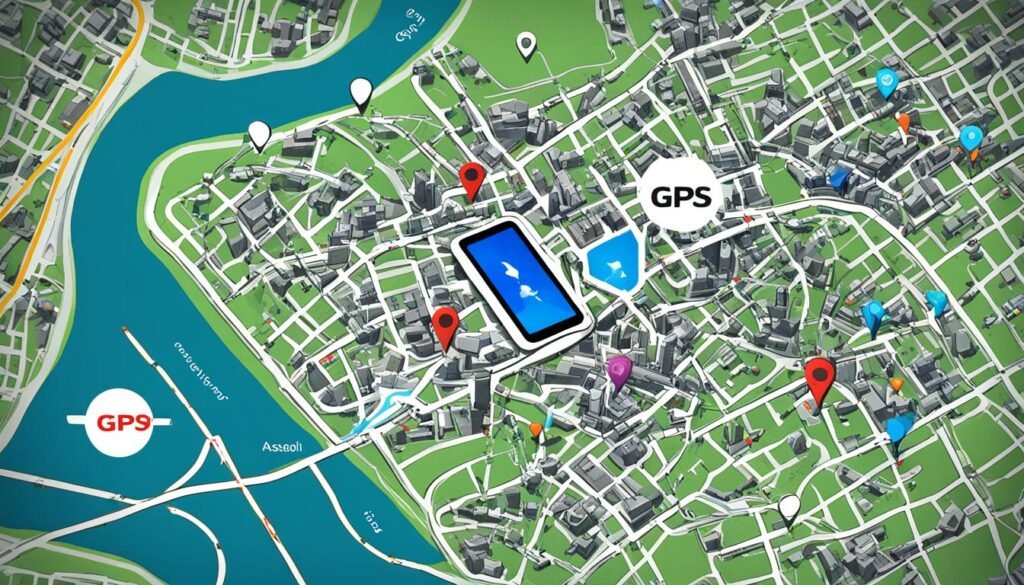In today’s digital age, GPS technology has revolutionized the way we navigate our world. With the advent of smartphones, GPS navigation has become an essential feature that allows us to find our way, discover new places, and reach our destinations with ease. But have you ever wondered how GPS navigation actually works on your phone? Let’s delve into the mechanics of GPS navigation on phones and uncover the fascinating technology behind it.
GPS navigation on phones relies on a complex system known as the Global Positioning System (GPS). This system consists of a network of satellites orbiting the Earth and GPS receivers built into our phones. By using a process called triangulation, these receivers calculate their precise location based on the signals received from multiple satellites simultaneously. This allows your phone to determine your position accurately and provide you with real-time navigation information.
GPS receivers in cell phones analyze the time it takes for signals to travel from GPS satellites to the receiver. By calculating the distance between the receiver and at least four satellites, the phone can triangulate its position and pinpoint its exact location. This information is then used to deliver turn-by-turn directions, show nearby points of interest, and assist in various location-based services.
Key Takeaways : GPS Navigation
- GPS navigation on phones relies on the Global Positioning System (GPS) and a network of satellites.
- Triangulation is used to calculate the precise location of the GPS receiver in a phone.
- GPS receivers measure the time it takes for signals to travel from satellites to determine distance.
- By analyzing signals from at least four satellites, phones can accurately determine their position.
- GPS navigation on phones enables turn-by-turn directions and location-based services.
GPS Basics
The Global Positioning System (GPS) is a remarkable technology that allows us to determine our precise location using satellites and GPS receivers. This section will delve into the fundamental principles of GPS and how it works on our phones.
GPS is a network of satellites orbiting the Earth. These satellites continuously emit signals that are picked up by GPS receivers in our phones. By receiving signals from multiple satellites, our phones can accurately calculate their position on the Earth’s surface.
Also Read : Securing Tomorrow: How To Build An Emergency Fund That Saves The Day
One of the key methods used in GPS is triangulation. Triangulation involves measuring the distance between the GPS receiver on our phone and multiple satellites simultaneously. This distance information is crucial for determining the precise position.
Triangulation enables GPS receivers to calculate their position on Earth by measuring the distance from multiple satellites.
Let’s take a closer look at the process of triangulation. The GPS receiver in our phone receives signals from at least four satellites. By analyzing the time it takes for the signals to travel from the satellites to the receiver, the GPS receiver can determine its distance from each satellite.
The distances to multiple satellites are then used to create intersecting spheres, with the GPS receiver at the center. The intersection point of these spheres represents the receiver’s location. Through this process, our phones are able to pinpoint our precise coordinates on Earth.
Also Read : Boost Your Career With An MBA In Finance Now!
To better understand the mechanics of GPS navigation, a table below summarizes the key elements of the Global Positioning System:
| Element | Description |
|---|---|
| Satellites | The network of satellites orbiting the Earth that emit signals used by GPS receivers. |
| GPS Receivers | The devices in our phones that receive signals from GPS satellites and calculate our position. |
| Triangulation | The method used by GPS receivers to measure the distance between the receiver and multiple satellites simultaneously. |
This table provides a concise overview of the essential elements that make GPS navigation possible on our phones. Now that we have a grasp of the GPS basics, let’s explore the principles of triangulation in more detail in the next section.
Triangulation Principle
GPS receivers in cell phones utilize a process called triangulation to calculate their location. This involves analyzing the time it takes for signals to travel from GPS satellites to the receiver. By measuring the distance between the receiver and multiple satellites, the phone can determine its precise location.
Triangulation relies on the principle that the receiver is at the intersection of several spheres, each centered on a GPS satellite. The distance from the receiver to each satellite can be calculated by comparing the time it takes for the signals to arrive.
Also Read : How Can Drones Be Used In Everyday Life?
The GPS receiver measures the time it takes for the signals to travel from the satellites. By analyzing these time measurements, the receiver can calculate its distance from each satellite and pinpoint its position on Earth.
The accuracy of the positioning depends on the distance between the receiver and the satellites. The closer the receiver is to the satellites, the more accurate the calculation will be. However, factors such as signal interference and the availability of satellites can impact the accuracy of the positioning.
To visualize this process, refer to the table below:
| Satellite | Signal Travel Time | Distance from Receiver |
|---|---|---|
| Satellite A | 14.2 ms | 4,271.2 km |
| Satellite B | 18.6 ms | 5,617.6 km |
| Satellite C | 22.1 ms | 6,732.3 km |
Using the data in the table, the GPS receiver can calculate its position based on the known locations of the satellites and the measured distances. By combining the information from multiple satellites, the receiver can determine the latitude, longitude, and altitude of the phone’s current location.
Understanding the triangulation principle is key to comprehending how GPS navigation functions on cell phones. By accurately measuring distances from GPS satellites, these devices can provide users with precise location information for efficient and reliable navigation.
Also Read : Us Money Reserve: The Place You Can Trust For Buying Gold And Silver

Satellite Signals and Time Synchronization
GPS satellites serve a crucial role in determining location accuracy for cell phone GPS receivers. These satellites transmit signals that include a time stamp and their precise location. By receiving signals from at least four satellites, the cell phone GPS receiver can triangulate its position based on the distance to each satellite.
Let’s take a closer look at how this process works. When a cell phone GPS receiver picks up signals from the satellites, it uses the time stamp information to calculate the distance between itself and each satellite. This is done by comparing the time it took for the signal to travel from the satellite to the receiver.
In order for this distance calculation to be accurate, the cell phone GPS receiver must have an internal clock that is synchronized with the satellite signals. The time stamp provided by the satellites serves as a reference point, allowing the receiver to accurately calculate the time it took for the signals to reach it.
Without proper time synchronization, the accuracy of the GPS positioning could be compromised. This is why it is essential for cell phone GPS receivers to maintain an accurate internal clock that is synchronized with the satellite signals.
Here’s an example of how the time synchronization works:
| Satellite | Signal Arrival Time | Distance from Receiver |
|---|---|---|
| Satellite 1 | 10:00:00 | 2,000 miles |
| Satellite 2 | 10:00:01 | 2,100 miles |
| Satellite 3 | 10:00:02 | 2,200 miles |
| Satellite 4 | 10:00:03 | 2,300 miles |
In this example, the signals from the four satellites arrived at the receiver at different times. By analyzing these time differences, the cell phone GPS receiver can determine its distance from each satellite, which is crucial in calculating its precise position.
Also Read : Explore New Possibilities With A Degree In Finance
By utilizing satellite signals and ensuring accurate time synchronization, cell phone GPS receivers can provide users with reliable and precise positioning information, enabling a wide range of navigation and location-based services.

Trilateration and Position Calculation
Once the GPS receiver has determined its distance from at least four satellites, it uses trilateration to calculate its precise position. Trilateration is a mathematical technique that involves determining the intersection point of three or more spheres, each with the receiver at the center and the distances to the satellites as the radii. This intersection point represents the receiver’s location.
To better understand trilateration, imagine each satellite as a sphere centered at its known location. The GPS receiver receives signals from these satellites, each with a unique distance measurement. By intersecting the spheres created by these distances, trilateration pinpoints the receiver’s position.
| Satellite | Distance from Receiver |
|---|---|
| Satellite A | 19,000 kilometers |
| Satellite B | 20,000 kilometers |
| Satellite C | 22,000 kilometers |
| Satellite D | 18,000 kilometers |
In the example table above, the GPS receiver has determined its distance from four satellites (A, B, C, and D). By visualizing these distances as spheres overlapping in space, the point where all the spheres intersect represents the precise location of the receiver.
Trilateration is a key step in the GPS position calculation process. By incorporating distance measurements from multiple satellites, the receiver can accurately determine its latitude, longitude, and altitude. This information enables the GPS navigation system to provide accurate positioning and guidance for various applications, from driving directions to location-based services.
Real-World Scenario:
Imagine you are hiking in a remote area and want to find your exact location using your phone’s GPS. The phone’s GPS receiver receives signals from four satellites, each with a unique distance measurement. Using trilateration, the receiver calculates the point where these spheres intersect, providing you with your precise coordinates, helping you navigate and explore with confidence.
Assisted GPS (A-GPS)
Many cell phones utilize Assisted GPS (A-GPS) technology to expedite the positioning process. A-GPS leverages data from cellular networks, including satellite ephemeris and almanac data, to assist the GPS receiver in quickly and accurately acquiring satellite signals.
The primary purpose of A-GPS is to enhance the speed and reliability of GPS navigation on cell phones. By accessing data from cellular networks, A-GPS can provide supplementary information to the GPS receiver, assisting it in acquiring satellites more efficiently.
One crucial aspect of A-GPS is its utilization of satellite ephemeris data. Satellite ephemeris refers to the precise satellite orbit and clock information. By having access to this data via cellular networks, A-GPS can reduce the time required for the GPS receiver to calculate satellite positions, enabling a faster positioning process.
“A-GPS technology allows cell phones to use additional data, such as satellite ephemeris and almanac data, obtained from cellular networks to expedite the GPS positioning process.”
Moreover, A-GPS uses almanac data from cellular networks, providing the approximate orbit and general health status of GPS satellites. This information further assists the GPS receiver in quickly identifying and acquiring satellite signals.
A-GPS can greatly benefit cell phone users in various scenarios. For instance, in urban environments with tall buildings or dense foliage, where satellite visibility may be limited, A-GPS can help improve signal acquisition. Additionally, in situations where the GPS receiver has not been used for an extended period, A-GPS can assist in acquiring satellites more rapidly, reducing the time required to determine the user’s position.
To summarize, Assisted GPS (A-GPS) technology enhances the performance of GPS navigation on cell phones by utilizing data from cellular networks, such as satellite ephemeris and almanac data. By leveraging this information, A-GPS facilitates quicker and more accurate satellite signal acquisition, improving the overall positioning experience for cell phone users.

| Benefits of A-GPS Technology | How A-GPS Technology Works |
|---|---|
| Faster and more reliable GPS signal acquisition | Accesses satellite ephemeris and almanac data from cellular networks |
| Improved performance in urban environments with limited satellite visibility | Assists GPS receiver in identifying and acquiring satellite signals |
| Reduces time required to determine user’s position | Utilizes data to expedite the satellite positioning process |
Factors Affecting GPS Accuracy
Several factors can impact the accuracy and reliability of GPS positioning on cell phones. Signal interference from buildings or natural obstacles, the number and positioning of available satellites, the quality of the GPS receiver, and atmospheric conditions can all affect GPS accuracy.
Signal interference is a common issue that can disrupt GPS signals and lead to inaccurate positioning. Tall buildings, bridges, and dense foliage can obstruct signals from GPS satellites, resulting in weak or distorted reception. This can cause errors in location tracking, especially in urban areas with high-rise structures or dense forests.
Satellite availability also plays a crucial role in GPS accuracy. The positioning and number of available satellites in the sky can vary depending on the location and time of day. If an individual is in a location with limited satellite visibility, such as deep canyons or dense urban environments, it can be challenging for a GPS receiver to obtain signals from multiple satellites simultaneously. This may result in reduced accuracy or an inability to determine a precise location.
The quality of the GPS receiver itself is another factor that can impact accuracy. GPS receivers vary in terms of their sensitivity, antenna quality, and processing capabilities. A higher-quality receiver is more likely to provide accurate and reliable positioning information compared to a lower-quality counterpart. Choosing a phone with a reputable GPS receiver can contribute to better overall accuracy.
Lastly, atmospheric conditions can affect GPS accuracy, although to a lesser extent. Factors such as solar flares, ionospheric disturbances, and extreme weather conditions can introduce small errors in GPS positioning. However, these atmospheric effects typically have minimal impact on everyday GPS usage and are often mitigated by the overall robustness of the GPS system.
To optimize GPS accuracy on cell phones, it’s advisable to ensure unobstructed visibility to the sky, especially when in challenging environments. Additionally, using a phone with a high-quality GPS receiver and regularly updating software can contribute to improved positioning accuracy. It’s important to note that these factors affecting GPS accuracy are generally beyond the control of an average user and are inherent limitations of the technology itself.
By understanding the various factors that can influence GPS accuracy, users can make informed decisions when relying on GPS navigation and location-based services on their cell phones.

Enhancements for GPS Accuracy
To improve GPS accuracy, cell phones can incorporate additional technologies and sensors. One such technology is Assisted-GNSS (A-GNSS), which combines GPS with other satellite navigation systems. A-GNSS helps to enhance positioning accuracy, especially in challenging environments such as urban canyons or areas with weak GPS signals.
A-GNSS works by utilizing data from multiple satellite navigation systems, including GPS, GLONASS, Galileo, and BeiDou. By integrating signals from these systems, A-GNSS provides more reliable and accurate positioning information.
Sensors also play a crucial role in improving GPS accuracy on cell phones. Accelerometers, gyroscopes, and magnetometers are commonly found in modern smartphones and can supplement GPS data.
Accelerometers measure changes in acceleration, allowing the phone to calculate its current speed and direction. This information helps in accurately estimating the user’s position, especially when the GPS signal is temporarily weak or unavailable.
Gyroscopes, on the other hand, measure angular velocity, enabling the phone to determine its orientation in space. By combining gyroscope data with GPS measurements, the device can better compensate for any movement or rotation, leading to more precise positioning.
Magnetometers detect changes in the Earth’s magnetic field. By using this information, cell phones can determine their heading or direction of travel, even when signals from the GPS satellites are obstructed.
These additional sensors, along with A-GNSS technology, provide valuable enhancements to GPS accuracy on cell phones. They help overcome limitations caused by urban canyons, signal obstruction, or weak GPS signals, resulting in improved location accuracy and a better user experience.
The integration of Assisted-GNSS technology and sensors like accelerometers, gyroscopes, and magnetometers allows cell phones to navigate through urban canyons and other challenging environments, providing users with more accurate positioning information.
In the context of urban canyons, where GPS signals can be significantly weakened by tall buildings and narrow streets, these enhancements become even more essential. The combination of A-GNSS and sensor data ensures that users can rely on their cell phones for accurate navigation and location-based services in metropolitan areas.
By leveraging these technologies and sensors, cell phones can overcome the limitations of traditional GPS navigation and provide reliable and precise positioning information, even in challenging environments.

Applications of Cell Phone GPS
GPS technology in cell phones has revolutionized navigation, providing turn-by-turn directions for walking, driving, and using public transportation. With the advancements in GPS technology, getting from one point to another has become more convenient and efficient than ever before.
One of the key applications of cell phone GPS is navigation. GPS-enabled mobile devices offer real-time mapping and navigation features, allowing users to plan routes, receive voice-guided directions, and avoid traffic congestion. Whether you’re exploring a new city, commuting to work, or embarking on a road trip, cell phone GPS navigation ensures you reach your destination with ease and accuracy.
In addition to navigation, cell phone GPS plays a crucial role in location-based services. With the help of GPS technology, users can quickly locate nearby businesses, restaurants, and attractions. Applications like Yelp and Google Maps leverage GPS data to provide users with recommendations based on their current location. Whether you’re in need of a caffeine fix, looking for a nearby park, or searching for the best shopping deals, cell phone GPS enables personalized and location-specific recommendations.
“Cell phone GPS has transformed how we explore and interact with our surroundings. From finding the nearest coffee shop to uncovering hidden gems in a new city, location-based services make every outing more enjoyable and convenient.”
GPS technology also plays a vital role in emergency services. During times of crisis, accurate location information is crucial for emergency responders. When making an emergency call from a cell phone, GPS technology provides precise location data, enabling first responders to quickly locate and assist individuals in need. This capability can be life-saving in situations where every second counts.
It is worth noting that while cell phone GPS has numerous benefits, accuracy can be affected by various factors such as signal interference and satellite availability. Nonetheless, advancements in technology continue to improve GPS accuracy and reliability, making it an indispensable tool in our daily lives.
Overall, the applications of cell phone GPS extend far beyond basic navigation. From finding the nearest coffee shop to helping emergency services locate individuals in distress, GPS technology on cell phones has transformed how we interact with our environment and navigate the world around us.
Benefits of Cell Phone GPS:
- Convenient and accurate turn-by-turn navigation
- Location-based recommendations for nearby businesses, restaurants, and attractions
- Essential for emergency services, enabling precise location information
- Improving everyday experiences and making journeys more efficient
In 2024, GPS navigation has become an indispensable tool in everyday life, with devices like Garmin providing real-time map updates and truck GPS systems offering alerts for optimal routes. Whether you’re driving an RV or a regular vehicle, Bluetooth connectivity allows for seamless integration with your navigator, ensuring smooth and efficient travel experiences. With the help of trackers and navigators, individuals can stay on course and navigate with ease, making GPS navigation an essential component of modern-day journeys.
In 2024, GPS navigation systems have evolved to become essential companions for both everyday drivers and commercial truckers alike. With a plethora of options available, including car GPS units and truck GPS navigation devices tailored specifically for commercial drivers, individuals can easily find the best GPS device to suit their needs. Navigation apps like Google Maps offer turn-by-turn directions and real-time updates, while devices such as the Garmin DriveSmart provide features like speed limit warnings and driver alerts for enhanced safety on the road.
With advancements like 7-inch touch screen displays and pre-installed lifetime maps for North America, GPS navigation systems offer convenience and reliability. Additionally, features like offline maps and satellite navigation ensure uninterrupted guidance even without an internet connection. Whether you’re navigating through urban landscapes or embarking on road trips, GPS navigation systems provide invaluable assistance, making driving easier and more efficient.
Also Read : Protect Your Inventions with technology Insurance
Conclusion
GPS navigation technology has revolutionized the way we navigate our daily lives. By utilizing the Global Positioning System (GPS), cell phones can determine precise locations with the help of satellites and receivers. This technology has a wide range of benefits and applications, making it an invaluable tool in various industries.
One of the key advantages of GPS navigation on cell phones is its versatility. It allows users to navigate through unfamiliar areas, whether they are traveling by foot, car, or public transportation. With turn-by-turn directions, users can confidently reach their destinations efficiently.
Moreover, GPS technology enables the development of location-based services. By leveraging GPS data, cell phones can provide users with information about nearby restaurants, attractions, and other points of interest. Additionally, GPS plays a crucial role in emergency services, allowing emergency responders to quickly locate individuals in need.
Understanding the mechanics of GPS navigation enhances our appreciation of its benefits and ensures optimal utilization. By integrating additional technologies and sensors, such as Assisted-GNSS and various sensors, GPS accuracy can be further improved. This is especially useful in challenging environments such as densely populated urban areas or areas with weak GPS signals.
Overall, GPS navigation technology has transformed how we navigate the world around us. Its benefits extend beyond simple navigation, encompassing a wide array of industries and services. As technology continues to advance, we can expect even more innovative applications of GPS navigation in the future.
FAQs
Q: What is GPS navigation and how does it work on phones?
A: GPS navigation is a system that uses a network of satellites to determine the exact location of a device. Phones with GPS capabilities can receive signals from these satellites to pinpoint their location on a map and provide navigation guidance.
Q: What are the benefits of using GPS navigation on phones?
A: GPS navigation on phones offers real-time location tracking, turn-by-turn directions, traffic updates, and the ability to find nearby points of interest. It helps users reach their destinations efficiently and safely.
Q: How accurate is GPS navigation on phones?
A: GPS navigation on phones can be very accurate, with most devices having an accuracy of around 5 meters under optimal conditions. Factors like weather, terrain, and signal interference can affect accuracy.
Q: Can GPS navigation work offline on phones?
A: Some GPS navigation apps offer offline maps, allowing users to navigate without an internet connection. This is useful in areas with poor network coverage or when traveling abroad.
Q: Are there specialized GPS navigation systems for trucks and commercial drivers?
A: Yes, there are GPS navigation systems designed specifically for trucks and commercial drivers. These systems offer features like truck-specific routing, speed limit alerts, and points of interest tailored for truckers.
Q: What features should I look for in a GPS navigation system for my vehicle?
A: When choosing a GPS navigation system for your vehicle, consider factors like real-time traffic updates, lifetime map updates, voice guidance, Bluetooth connectivity, and compatibility with your device.
Q: How do I update the maps on my GPS navigation system?
A: Most GPS navigation systems offer map updates either through a software program on your computer or directly through the device. It’s important to regularly update the maps to ensure accurate navigation.
Source Links
- https://www.androidcentral.com/how-does-gps-work-my-phone
- https://www.blackview.hk/blog/tech-news/how-do-phones-gps-work
- https://www.reddit.com/r/explainlikeimfive/comments/repk8r/eli5_how_does_gps_work_in_smart_watchesphones_who/




